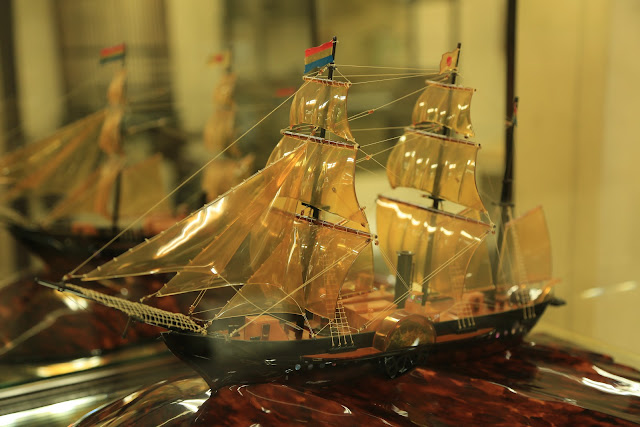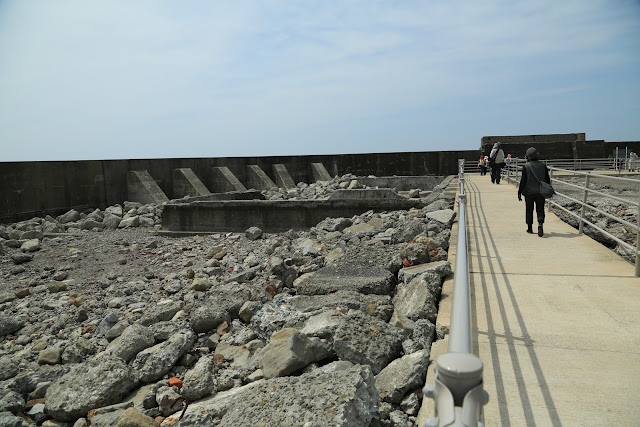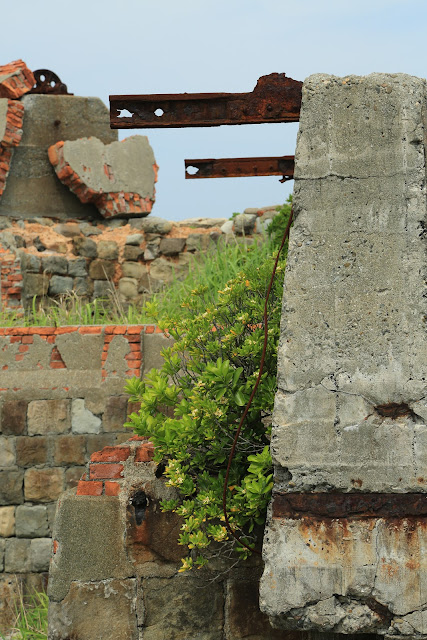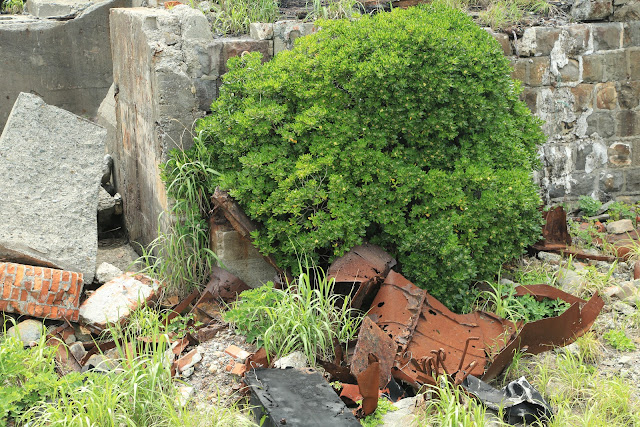
Tongs and pincers used in a Meiji workshop in Nagasaki ("meaning "long cape") , the capital and the largest city of
Nagasaki Prefecture, center of Portuguese and other
European influence from 16th through 19th centuries. For a long time now, Nagasaki has been a trading and manufacturing city, but not until
the Portuguese ship arrived in 1543 at Tanegashima Bay, when it was only a small fishing village. Soon after that Portuguese ships were plying busily between Japan and the rest of the world, especially between Japan and China because at the time, official contact between which was prohibited on account of various incidents in the South China Sea involving Wokou pirates (倭寇). The
Portuguese merchants served the much needed role of intermediaries between the two nations.
Everything changed radically when St. Francis Xavier came to Kagoshima in 1549 and converted huge numbers of Japanese to Catholicism, including many daimos eg. Omura Sumitada, who profited from the relevant sea trade so that in 1569, he gave permission for a port to be built in Nagasaki to accommodate the Portuguese merchant fleet. In 1571, the port was completed under the joint supervision of the Jesuit missionary Gaspar Vilela and Portuguese Captain-Major Tristão Vaz de Veiga, with the active help of Omura. The opening of the port brought such novelties into Japan as tobacco, bread, textiles and the Portuguese sponge-cake called "castellas" (or castle cake) still popular now in Nagasaki and also the famous Japanese "tempura" (from a popular Portuguese recipe known as "peixinho-da-horta") a Japanese name derived from the Portuguese word, 'tempero'
For a brief period after 1580, Sumitada decided to pass over control of the Catholic city of Nagasaki to the Jesuits through its leader Alexandro Valignano because of political instability in Japan during the Sengoku period and the city became a refuge for persecuted Christians from all other parts of Japan but in 1587 when Toyotomi Hideyoshi's unification campaign reached Kyūshū, he was alarmed at the powerful influence of the Jesuits had over southern Japan and ordered all missionaries expelled but such order met with strong resistance and most of Nagasaki's population remained openly Catholic.
In 1596, when Hideyoshi learned from the pilot of a Spanish ship San Felipe, shipwrecked off the coast of Shikoku that the Spanish Franciscans had plans to gain more political control of Japan, he immediately ordered 26 Catholics to be executed in Catholic Nagasaki on February 5 of that year (i.e. the famous "Twenty-six Martyrs of Japan") but Portuguese traders were still permitted to carry on their commercial activities and the city remained prosperous.
In 1602, Augustinian missionaries also arrived in Japan. When Tokugawa Ieyasu first took power in 1603, he still tolerated Catholicism but after he took over control of Osaka Castle and Toyotomi Hideyoshi's offspring were killed, he issued a ban on Catholicism in 1614 but continued to allow the Dutch and English merchants to trade. In their own interest, most Catholic daimyo apostatized. and forced their subjects to do likewise. The few who would not recant left the country for Macau, Luzon and Japantowns in Southeast Asia. A brutal persecution campaign followed, with thousands of converts in Kyūshū and other parts of Japan killed, tortured, or forced to renounce their religion.
After the Rebellion of Shimabara (a Christian han) in 1637, the Japanese government decided that Christianity was more a bane than a boon and ordered that all Portuguese, hitherto living on a specially constructed island-prison in Nagasaki harbour called Dejima, be expelled from the archipelago altogether. The Dutch merchant community were also moved from their base at Hirado into Dejima island.
In 1720 the ban on Dutch books was lifted,. This caused hundreds of scholars to flock into Nagasaki to study European science and art. Consequently, Nagasaki became a major center of rangaku, or "Dutch Learning".
During the Edo period, the Tokugawa shogunate had the city under its direct control through appointing a hatamoto, the Nagasaki bugyō, as its chief administrator. But not only were Dutch found at Nagasaki, the Chinese Tōjinyashiki (唐人屋敷) or Chinese Factory in Nagasaki also played an important role in the Japanese market. Some scholars believe that as much as one-third of the population of Nagasaki at the time may have been Chinese. Various colourful Chinese merchants and artists sailed between the Chinese mainland and Nagasaki. Some, like Yi Hai in the 18th century, actually combined the roles of merchant and artist .
Following the opening of Japan in the Meiji Restoration, Japan opened its doors once again to foreign
trade and diplomatic relation. in 1859, Nagasaki became a free port and in 1868, modernization began in earnest. In 1889, Nagasaki was officially
proclaimed a city. With Christianity legalized and the
Kakure Kirishitan coming out of hiding, Nagasaki regained its earlier
role as a center for Roman Catholicism in Japan.It was also during this period that Nagasaki became a center of heavy industry, concentrating on ship-building, its dockyards under Mitsubishi Heavy
Industries became one of the prime contractors for the Imperial
Japanese Navy, and Nagasaki harbor a military port under Sasebo Naval District.
During World War II, at the time of the nuclear attack on August 9, 1945, Nagasaki had become one of Japan's most important industrial cities containing both plants of the Mitsubishi Steel and Arms Works, the Akunoura Engine Works, Mitsubishi Arms Plant, Mitsubishi Electric Shipyards, Mitsubishi-Urakami Ordnance Works, several other small factories, and most of the ports storage and trans-shipment facilities, which engaged some 90% of the city's labor force, and accounted for an equal percentage of the city's industry. Such military industries and their links with the Japanese war effort made Nagasaki a major target for bombing by the Allies during the war.
During World War II, at the time of the nuclear attack on August 9, 1945, Nagasaki had become one of Japan's most important industrial cities containing both plants of the Mitsubishi Steel and Arms Works, the Akunoura Engine Works, Mitsubishi Arms Plant, Mitsubishi Electric Shipyards, Mitsubishi-Urakami Ordnance Works, several other small factories, and most of the ports storage and trans-shipment facilities, which engaged some 90% of the city's labor force, and accounted for an equal percentage of the city's industry. Such military industries and their links with the Japanese war effort made Nagasaki a major target for bombing by the Allies during the war.
The 12 months before the the nuclear attack, Nagasaki had already been bombed 5 times by 136 planes dropping some 270 tons of high explosive, 53 tons of incendiary, and 20 tons
of fragmentation bombs, with several bombs hitting the Mitsubishi Steel
and Arms Works, and six at the Nagasaki Medical School
and Hospital, with three direct hits on buildings there. While the
damage from these few bombs was relatively small, it created
considerable concern in Nagasaki and a number of people, chiefly school children, were evacuated to rural areas for safety, thus reducing
the population in the city at the time of the atomic attack.
On
the day of the nuclear strike on Thursday, August 9, 1945,Nagasaki had a population of about 263,000 (
including 240,000 Japanese residents, 10,000 Korean residents, 2,500 conscripted
Korean workers, 9,000 Japanese soldiers, 600 conscripted Chinese
workers, and 400 Allied POWs)That day, the Boeing B-29 Superfortress
Bockscar, with a plutonium bomb code
named "Fat Man" under the command of Major Charles Sweeney left the Tinian's
North Field just before dawn, its primary target being Kokura and if weather there was too cloudy, then Nagasaki. When the bomber reached Kokura at 9:44 a.m. (10:44
a.m. Tinian Time), the city was shrouded in cloud and smoke as nearby city of Yawata had just been been firebombed the previous day. Unable to
make visual identification and constrained by limited fuel, the plane then left for Nagasaki at 10:30 a.m. Some 20 minutes later, it arrived at Nagasaki,
but it too was hidden in clouds. After several unsuccessful bombing runs the crew was forced to use radar in order to drop the bomb. At
the last minute, an opening in the clouds allowed them to make visual
contact with a racetrack in Nagasaki, and they dropped the bomb on the
city's Urakami Valley,midway between the Mitsubishi Steel and Arms Works
in the south, and the Mitsubishi-Urakami Ordnance Works in the north.
The bomb exploded 1,800 feet above ground 53 seconds after release ( at 11:02 a.m). In less than a second, the whole of the northern Nagasaki was
wiped out, with 39,000–80,000 people killed (half of whom dying instantly with the rest suffering lingering deaths) including 6,200 of the 7,500 Mitsubishi
Munitions Plant employees, thousands of others (including 2,000 Koreans) working in other war plants and factories and 150
Japanese soldiers.
The damage to the industrial facilities Nagasaki was extensive partly because the inadvertent targeting of the industrial zone left 68-80 percent of the non-dock industrial facilities destroyed. Though the bomb was somewhat more powerful than the "Little Boy" bomb dropped over Hiroshima, because of Nagasaki's more uneven terrain, there was less damage.Two years after the bombing, plants growing at ground zero presaged the frightening genetic aberrations to appear later in humans: sesame stalks produced 33 percent more seeds but 90 percent of them were sterile. For decades abnormally high amounts of cancer, birth defects, and tumors haunted victims of the plutonium bomb
After the war, Nagasaki was rebuilt but the pace of reconstruction was slow: no emergency housing was provided until 1946. The city's first priority was to rebuild military industries and foreign trade related shipbuilding and fishing. Only in 1949 May was the Nagasaki International Culture City Reconstruction Law passed whereby new temples and new churches were built to satisfy the needs of the increasing number of religious adherents. New structures were also raised as memorials, such as the Atomic Bomb Museum, Peace Parks etc.
The damage to the industrial facilities Nagasaki was extensive partly because the inadvertent targeting of the industrial zone left 68-80 percent of the non-dock industrial facilities destroyed. Though the bomb was somewhat more powerful than the "Little Boy" bomb dropped over Hiroshima, because of Nagasaki's more uneven terrain, there was less damage.Two years after the bombing, plants growing at ground zero presaged the frightening genetic aberrations to appear later in humans: sesame stalks produced 33 percent more seeds but 90 percent of them were sterile. For decades abnormally high amounts of cancer, birth defects, and tumors haunted victims of the plutonium bomb
After the war, Nagasaki was rebuilt but the pace of reconstruction was slow: no emergency housing was provided until 1946. The city's first priority was to rebuild military industries and foreign trade related shipbuilding and fishing. Only in 1949 May was the Nagasaki International Culture City Reconstruction Law passed whereby new temples and new churches were built to satisfy the needs of the increasing number of religious adherents. New structures were also raised as memorials, such as the Atomic Bomb Museum, Peace Parks etc.
metal saws and cutters
Various vessels, combs and decorations made with bones
newer minted coins
a grinding bowl for Japanese mustard?
An old photograph of Japanese rickshaws showing ladies in Western style clothes in early 20th century
Nagasaki has been a trading port since the mid 17th century: A model of an early steamer.
More examples of bone sculptures of two fish called "鰹 "
A Kabuki (歌舞伎) doll. The Kabuki theatre, a combination of song, dance and drama first started in or about 1603 by 出雲阿國 and continued uninterrupted to today, an art which became firmly established in the Genroku era (元祿年間)(1688~1704.) This style of theatre does not aim at "realism" but at "verisimitude" of emotions and since 2009 has been accepted by the UN as "intangible cultural heritage".
Two wooden cranes crafted in 1961 by an artist called 江崎榮一
A domestic Primer about measures to be taken during an air raid issued by the city of Nagasaki during WWIII
Some primitive goggles, gas mask and helmet used in Nagasaki
Some materials transformed by the heat of the A-bomb. During World War II, the atomic bombings of
Hiroshima and Nagasaki made Nagasaki the second and, to date, last city
in the world to experience a nuclear attack.
A model of one of the battle ships destroyed during the A-bomb attack
Some of the materials retrieved from that battle ship.

A public toilet close to the museum
After lunch, we were taken a small deserted island close to Nagasaki called Hashima (端島) ("shima" meaning "island"), popularly called Gunkanjima (軍艦島) (meaning "Battleship Island") about 9 miles from the city, one of the 505 uninhabited islands in Nagasaki Prefecture. Submarine coal deposits were first discovered there in 1887 and 3 years later Mitsuibishi (the Mitsui family then being one of Japan's most influential daimyo at the time) bought the island to exploit such coal for the energy needs of Japan's rapid industrialization. In 1919, they built there Japan's first large-scale concrete apartment buildings (9 stories high) to house the workers.
In the 1930s, many Koreans and Chinese were brought in as forced slave labor. At its height, the 6.3 hectare island housed some 5,260 people, equivalent to a population density of 835 people per hectare for the island as a whole or 1,391 per hectare for the residential area alone, the highest in Japan.
In the 1960s, as petroleum increasingly replaced coal as industrial fuels, demand for coal fell drastically so that by 1974, the mines had to be closed. Before then, even in 1970, the Nomo Shosen Line still operated 12 round trip ferry service (50 minutes each way) a day to and from the Nagasaki Port via Ioujima Island and Takashima Island but when the mines were closed, such service ended. Now all that is left are the dilapidated remains of former buildings.
In 2002, the island was returned without payment by Mitsubishi to the Takashima town and when the latter was merged with Nagasaki in 2005 and it came under the direct control of Nagasaki city. Until April 2009, when some parts of the island were open for tourist visits, only journalists were allowed there.
In 2008, the Japanese Agency for Cultural Affairs added the island to its tentative list of "The Modern Industrial Heritage Sites in Kyushu and Yamaguchi" and applied for it to be included as one of the the UNESCO World Heritgage Sites, an application which Korea strongly objected because it once used forced Chinese and Korean labor both in the 1930s and during WWII. But on May 4, 2015 the UNESCO advisory panel recommended that the application be granted.
At the moment, 5 companies are already operating "round the island" sightseeing boat trips of Hashima from the Nagasaki Port,viz. Gunkanjima Concierge, Gunkanjima Cruise Co., Ltd., Yamasa-Kaiun, and Takashima Kaijou plus another private service operating from the Nomozaki Peninsula.

Part of the buildings. Closest to the foothill and running parallel to it are the pillar supports of the coal conveyor belt. At its height, there were residential apartments, a restaurants, barber shops and other provision stores, a hospital, a school, a cinema, a public bath and even a temple on the island. But there is no place to grow things. So they made use of the roofs to form rooftop gardens for flowers and vegetables. They made use of the open spaces between the buildings as open air markets. The mining shafts were located at 10 different levels beginning at 350 meters beneath the surface and the deepest at 1010 meters beneath the surface. Since its workers had to work underground in temperatures of up to 30 degrees Celsius and humidity of 95% and had to risk intense heat and humidity in the wet and slippery mining tunnels as well as methane gas poisoning or explosion deep within the bowels of the earth, they were paid much higher wages than the average factory or mining workers. Whenever miners met one another, they wouldn't say, "how are you?" but "Be careful and don't forget safety precautions" or "absolutely no accident!" . From this, one gets an idea of how dangerous it would be working there.
Nothing, no workers, no managers, no shopkeepers, no cooks and nobody but rubble there now.This used to be coal cart repair centre right next to the coal storage area
Rusted iron girders everywhere
This used to the where the shops and public baths were located. The tallest structure in this photo is what remains of the lift tower to the No,. 2 mining shaft.
All broken down by merciless weathering of more than 4 decades of storms and typhoons
A hole in the sea wall
The light tower to guide the ferry service at the top of the hill is still in full operation
These used to be the residential quarters. The overground coal conveying belts ran
across the front of the houses.
across the front of the houses.
Another part of the former apartments

The structure of the former walls are still visible. We were told by the island guide that over the years when the island was under its control, the Mitsubishi Corporation had extended the boundaries of the island to three times its original area under 6 successive reclamation projects.
Specially constructed visitors paths have been built to facilitate the tours; there are now tours in Japanese, English, German, French, Korean and Mandarin. In the background is the seawall, which still seem as good as ever.
Another view of the abandoned apartments. Behind these, there would be a godown, an office, a mine machinery workshop, a metal smelting furnace, offices and conference rooms and even a children's playground.
The quality of the bigger metal rods appear good: still no rust after so many years
A good panoramic view of the sea from the windows of the former recreation area
Part of the recreation area terraces
Another view of the tumble down buildings
To the left of the photo, one could still see the pillars supporting the coal conveyor belt. What were such rotors used for?
A lone bird hovering over the deserted island
plus some other silent occupants
metal scraps appear to provide excellent cover for the roots
There's always advantage climbing higher: more sun.
Why have these been left behind and not others
These walls appear to have been repainted, probably for the benefit of photographers and tourists?
A final look before getting back on to the boat.
Little but sea and sky around the deserted island
Mooring pillars
A view of the island from afar
the front of the island
the uninhabited part of the island to the right
The most densely populated part: a bit like our public housing estate
like this one
But not from this.
One of the many bridges in Nagasaki
Another one
our ferry now directly under the bridge
passed it
Some of the headlands
churches
a small off shore island
another bridge
like the one in Tsing Yi
A huge dry dock
another bridge closer to city centre
Finally the ferry pier
A tourist sailing ship
One of the many bridges in Nagasaki
Another one
our ferry now directly under the bridge
passed it
Some of the headlands
churches
a small off shore island
another bridge
like the one in Tsing Yi
A huge dry dock
another bridge closer to city centre
A tourist sailing ship






























































沒有留言:
張貼留言